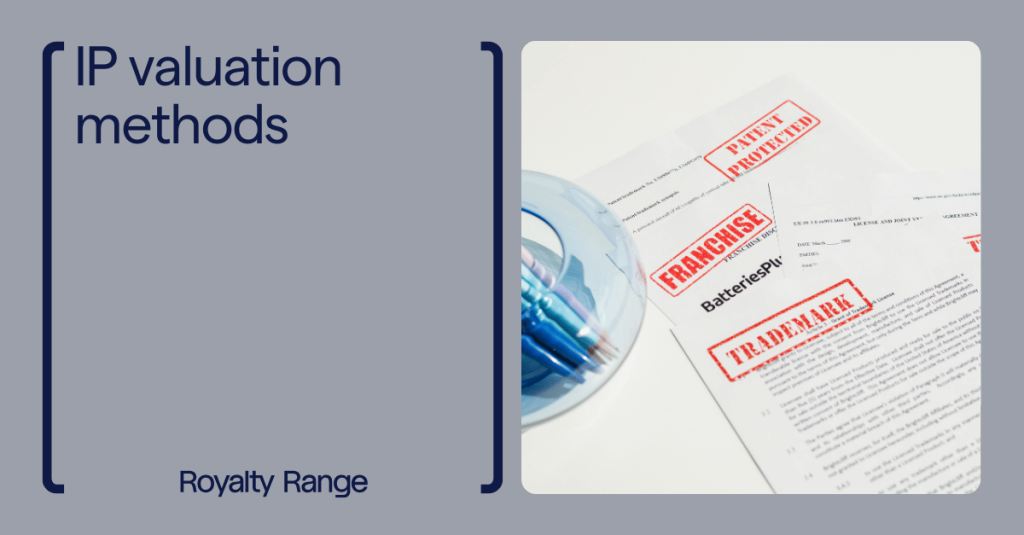IP valuation methods
RoyaltyRange

In today’s fast-paced business environment, Intellectual Property (IP) is an important element of innovation, uniqueness, and competitive edge. Assets such as patents, trademarks, copyrights, and trade secrets are vital in driving the success and expansion of companies across various sectors. However, grasping the real worth of Intellectual Property goes beyond just recognizing creativity or innovation; it is a strategic necessity with considerable financial consequences.
The value of an IP asset primarily arises from its ability to prevent competitors from entering a specific market, which directly impacts the future economic benefits it will generate. While the legal rights associated with IP provide exclusivity or the power to exclude others, the true economic value lies in the exclusive control over the asset’s use. Understanding the economic worth of your IP assets is crucial for various transactions, including licensing, selling, donating IP rights, or engaging in joint ventures and other collaborative partnerships.
Depending on the type of intangible assets you own, integrating IP protection and management into your business strategy is crucial. Various legal mechanisms are available to safeguard and optimize their use, and these assets are legally protected with their protection enforceable in court.
In these circumstances, IP valuation becomes essential for assessing the monetary worth of a specific intellectual property asset. There are three primary methods of IP valuation, which we can explore in more detail.
Income method
The income method is the most widely used approach for valuing intellectual property, especially when selling or buying a business or licensing IP. This method estimates the value of an IP asset based on the expected economic income it will generate, adjusted to its present value. This method is particularly simple to apply for IP assets with positive cash flows, where future cash flows can be reliably estimated, and where a suitable risk proxy can be used to determine discount rates.
Income methods forecast potential future revenue, cost, and risk of IP. These forecasts are used to determine the IP’s net present value (NPV), which can be either positive or negative. Common examples of income-based valuation methods include discounted cash flow (DCF), capitalization of earnings, and relief from royalty methods.
Pros:
- Considers future economic benefits of the IP.
- Can be very accurate if the future cash flows and discount rates are well estimated.
Cons:
- Requires detailed financial forecasts and assumptions.
- Sensitive to changes in assumptions, making it potentially uncertain.
Market method
The market method relies on comparing the price paid for the transfer of rights to a similar intangible under comparable conditions. Its main advantage is its simplicity and reliance on market data, making it useful for estimating approximate values. This method is frequently used to establish royalty rates, determine tax values, and support income-based valuation methods. It can be applied in various scenarios, such as determining fair royalty rates for licensing intellectual property, justifying a business’s value in corporate disputes, presenting valuations to tax authorities for tax defense, or setting a fair price in business acquisitions or sales.
To effectively apply the market method, you must have access to data on transactions involving comparable intellectual property. Specialized databases can supply reliable comparables for this purpose. By analyzing transaction prices or royalty rates, you can estimate a fair value for the IP. However, it is essential to adjust for specific business contexts, such as litigation or bankruptcy, which could affect the transaction conditions.
Pros:
- Reflects actual market conditions and demand.
- Useful when comparable transactions are available.
Cons:
- Difficult to find truly comparable IP assets.
- Market data might not always be available or accurate.
Cost method
The cost method values the IP by estimating the cost to create a similar or identical asset. This approach is commonly used for valuing patents, portfolios, and in situations involving licensing or seeking investments. It is especially useful when the IP can be easily replicated and when the economic benefits are difficult to measure. However, this method does not factor in any wasted costs or the unique features of the asset.
The cost-based method assesses the expenses associated with creating and developing an IP asset, such as machinery, equipment, labour, legal fees, testing, and overheads. This approach considers either the historical costs of developing the existing IP or the costs that would be incurred to develop similar Intellectual Property. The rationale behind aligning costs with value is that purchasing IP rights from the owner would avoid these development expenses, as the IP is already fully developed.
Pros:
- Simple and straightforward.
- Useful for valuing IP in its early stages.
Cons:
- Does not account for the future economic benefits of the IP.
- May not reflect the true market value, especially if the IP has significant market potential.
Regardless of the method chosen, valuing an IP requires gathering extensive information about the asset and thoroughly understanding the economic conditions, industry trends, and specific business factors that influence its value.
For accurate valuation data, contact us for a live demo or trial access, or get started immediately by filling out the One Search form.
Sources:
https://www.wipo.int/sme/en/ip-valuation.html
https://academic.oup.com/book/41122/chapter/350443651
https://www.wipo.int/export/sites/www/sme/en/documents/pdf/ip_panorama_11_learning_points.pdf